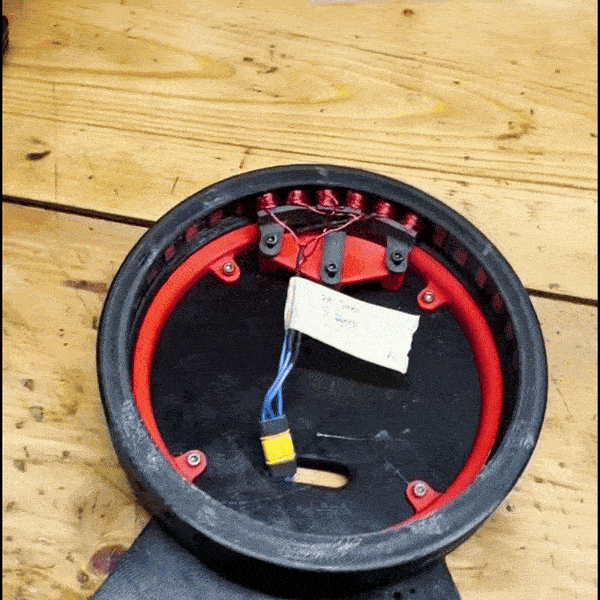Hello FigureAI
Thank you for taking the time to look at my application.
I have the perfect skill set to be an amazing Mechanical Engineering Intern before starting graduate school this Fall and I want to prove it to you on this webpage.
I know you have limited time so I will keep this brief:
I am all about CAD-ing systems to the highest standards
When I led Northeastern University’s drone research club (NUAV), I modeled tons of assemblies ensuring parts were functional, manufacturable, and assemblable. Peak examples include Tarsier and LIZARD. With Tarsier, I modeled a complex bevel gear mechanism with 0.1mm of tolerance to move an Intel RealSense camera in sync with the pitch angle of our research drone. With LIZARD, I independently designed, modeled, built, and tested five drone designs over seven months. Because of my rigorous design methods, I built an autonomous quadcopter platform 79% smaller than old club drones with a 4.1 thrust-to-weight ratio.
I can build and automate hardware tests to collect/analyze vast amounts of data
While working at Amazon Robotics, I ran automated conveyor tests to determine which conveyor parameters would lead to the fastest tote delivery time within a consistent range of stopping positions.
I coordinated with vendors, wrote PLC programs, and calibrated my test setup to measure tote positions accurately for days on end. I also wrote Python scripts to parse hundreds of thousands of data points, find the most relevant data, and report the effective stopping positions. I then analyzed the data with ANOVAs and linear regressions, clearly and thoroughly documenting my steps along the way.
Because of my work, conveyors are optimized for tote delivery, and people use my findings and automated test setup to assess more conveyor parameters and further enhance company productivity.
I know how to build tightly toleranced parts and hold them to standard
At Desktop Metal, I put my years of SolidWorks experience to use by modeling part features, checking form, fit, & function within company assemblies, running FEA simulations, and creating technical drawings by the ASME Y14.5 standard. The company’s custom forklift interfered with one of the printers, which halted production. It was up to me to find a retrofit that would bring back system-wide functionality.
So, I modeled aluminum parts in SolidWorks, mated them in our top-level assemblies, and verified that my designs would fit within our system. I then ran SolidWorks FEA simulations to check that the parts and bolt connections could withstand loads up to 600kg. I even cross-checked these with hand calculations to ensure the simulations ran accurately.
Finally, I applied GD&T in my SolidWorks technical drawings by specifying flatness, clearance, MMCs, concentricity, and true position features. I then machined these parts myself, which taught me to design for machinability and successfully restored the production line of printers as I secured my parts onto our forklift.
I know how to build brushless DC motors from scratch and simulate physical models!
I am working on a personal project where a friend and I are 3D printing a BLDC motor with a partially complete stator to make our motor uniquely lightweight, yet functional.
I have surveyed and uncovered what materials are best for the rotor and the stator. I understand the governing differential equations of BLDC motors and use them to model torque simulations with pyFEMM and find optimal stator-rotor combinations. I also understand intuitively the core components of motor design such as back irons, Halbach arrays, winding factor, slot-pole ratios, and more!
I’ve also used MATLAB to simulate differential/partial differential equations using RK2, implicit/explicit, and Crank-Nicholson methods, as part of my Intro to Computational Fluid Dynamics class.
In short, I am an up-and-coming M.S. in Robotics student who loves building automated test setups, collecting data, and finding the most optimal designs.
I’ve already modeled hundreds of SolidWorks parts and assemblies to satisfy load conditions, meet ASME Y14.5 standards, and hold to form, fit, and function. I’ve run FEA simulations and checked them with hand calculations to justify my design choices. I’ve also designed, set up, tested, and analyzed automated hardware tests, to optimize robot operations. That’s not to mention my time leading Northeastern University’s drone research club, working across multi-disciplinary teams, and understanding/implementing system-wide goals.
I check off all the boxes, and if you accept me as an intern, you will have an engineer with a relentless drive to uncover the most optimal mechanical designs, which will make Figure 02 (or the upcoming Figure 03) harder, better, faster, stronger.
I look forward to hearing back soon and talking to you about my projects.
Kindest Regards,
Daniel T. Simpson







